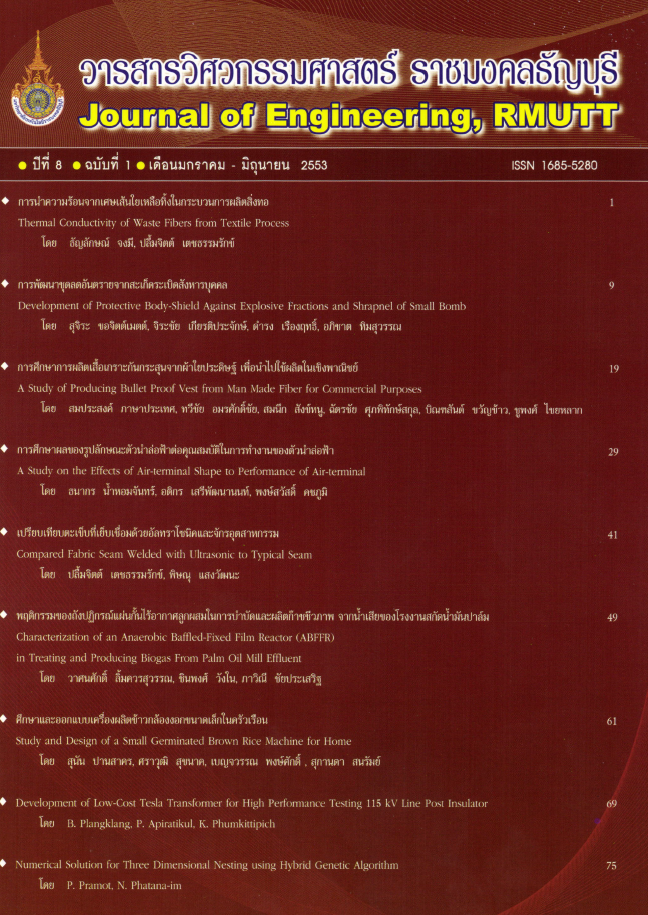A Study of Producing Bullet Proof Vest from Man Made Fiber for Commercial Purposes
Main Article Content
Abstract
The main objective of the study was to investigate suitable fabric structures that use for making the bullet proof vest. The vest should be made from the fabric producing from synthetic fiber and it should be withstand the bullet level 3A according to NIJ standard. Three fabric structures were examined i.e., woven, knitted and non-woven. Another aim of the study was to build a device that use to detect an impact force of the bullet.
Woven fabric was made with 100 denier high tenacity polyester both warp and weft yarn. Ends and picks per inch were 32 and 64, respectively. This fabric was brought to make the bullet proof vests. The weight per unit area of the vest was about 22.79 kg/m[superscript2]. These panels, in wet state, were tested with the bullet level 34 according to NIJ standard. The detected impact force device was designed consisting of four parts: (1) impact force part (2) measuring force transducer (3) electrical detector and (4) data acquisition. To test this device, three bullet proof panels were used to test by shooting with the bullet level 2A. Each panel weight per unit area was 13.88 kg/m[superscript2]. The first panel was made from the woven fabric mentioned above. The second panel was built from weft insertion warp knitted fabric producing from high tenacity polyester of warp and weft yarn. While the loop forming yarn of this fabric was the polyester. Another panel was made from three dimensional woven fabrics weaving from high tenacity polyester both warp and weft yarn. The last one was the panel from a sheet of non-woven fabric which produced from polyethylene.
From the testing, it was found that the bullet proof vests made from 2x2 basket woven fabric could withstand the bullet by level 3A. The result of testing the detected impact force device with three bullet proof panels showed that two and three dimensional graphics could be obtained. Three panels could also withstand the bullet level 2A. except the one made from three dimensional woven fabrics. However, it could resist the bullet level I (.38 special LRN). Since the bullet proof vest making from woven fabric could be reach the NIJ standard level 3A, fifty bullet proof vests were produced. These bullet proof vests were given to Thailand Textile Institute in order to contribute to Thai Air Force Army who have right of controlling the production of the vests.
Article Details
The manuscript, information, content, picture and so forth which were published on Frontiers in engineering innovation research has been a copyright of this journal only. There is not allow anyone or any organize to duplicate all content or some document for unethical publication.
References
สมประสงค์ ภาษาประเทศ และคณะ การศึกหาการผลิตเสื้อเกราะกันกระสุนจากผ้าใยประดิษฐ์ เพื่อนำไปใช้ผลิตในเชิงพานิชย์ ระยะที่1 ศึกษาส้นไขและโกรงสร้างที่เหมาะสมในการผลิตเสื้อเกราะกันกระสุน รายงานการวิจัยพัฒนา Technical Textiles สนับสนุนทุนวิจัยโดยสถาบันพัฒนาอุตสาหกรรมสิ่งทอประจำปี 2550
นะราเฉลิมกลิ่น และ ฉัตรชัยศุภพิทักย์สกุล"การออกแบบทรานสดิวเซอร์วัครงโดยใช้ฮอลเอ็ฟเฟคทเซ็นเซอร์", การประชุมเครือข่ายวิชาการ วิศวกรรมไฟฟ้า มหาวิทยาลัยเทคโนโลยีราชมงคล ครั้งที่1 คณะวิศวกรรมศาสตร์มหาวิทยาลัยเทคโนโลยีราชมงคลรัญบุรี จังหวัดปทุมธานี, 19-21 พฤศจิกายน 2551: GEN18.
นะราเฉลิมกลิ่น และฉัตรชัยศุภพิทักษ์สกุล,"การประยุกต์ใช้ฮอลเอ็ฟฟคทเซ็นเซอร์ในการออกแบบทรานสคิวเซอร์วัดแรง", การประชุมวิชาการทางวิศวกรรมศาสตร์มหาวิทยลัยสงขลานครินทร์ ครั้งที่ 7 คณะวิศวกรรมศาสตร์ มหาวิทยาลัยสงขลานครินทร์ วิทยาเขตหาดใหญ่ จังหวัดสงขลา, 21-22 พฤษภาคม 2552: PEG70R 118.
NIJ Standard-0101.06, Ballistic Resistance of Armor, U.S. Department of Justice, 2005.
Hearle J.W.S, Atlas of fibre fracture and damage to textiles, Woodhead Publishing,England, 1998
Wilson, J, Handbook of textile design,Woodhead Publishing, England, 2001.
Lewin, M, Handbook of Fiber Science and Technology, Volume 3, Marcel Dekker, New


